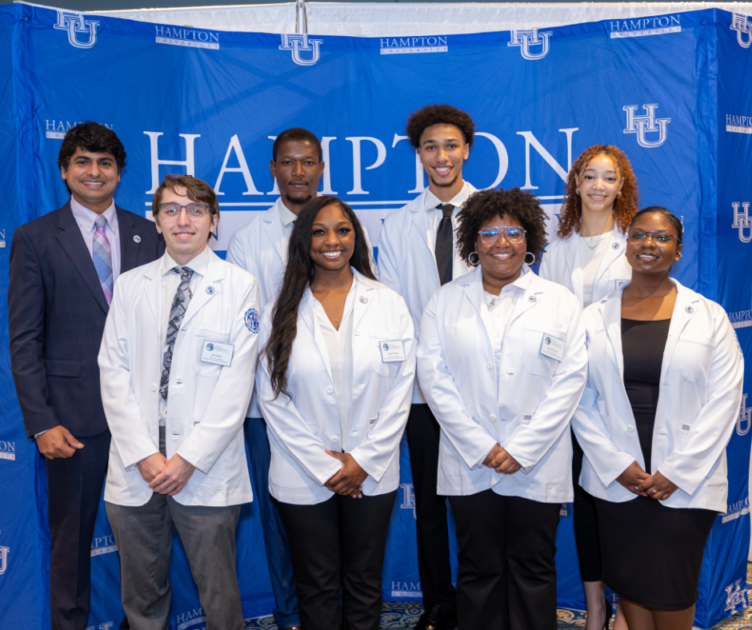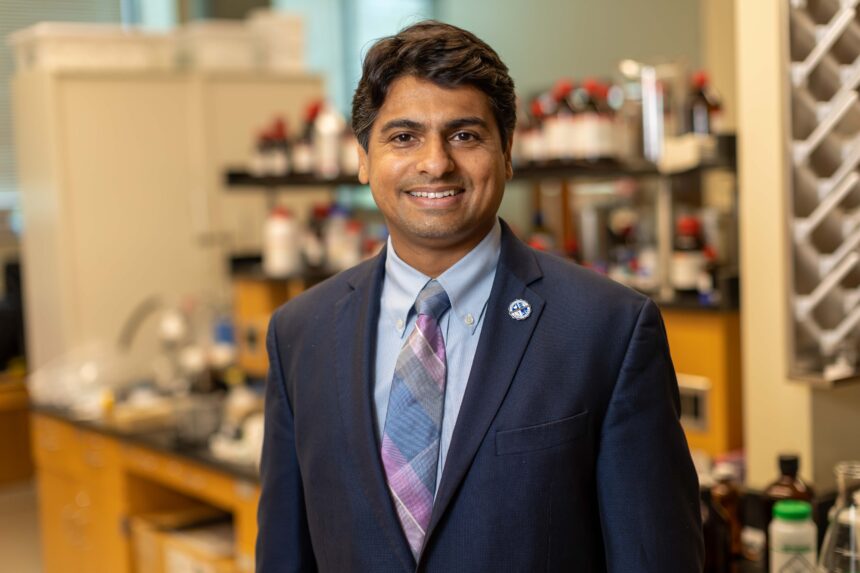By: Dr. Anand Iyer, Dean
School of Pharmacy, Hampton University
At Hampton University’s School of Pharmacy, the journey from classroom to community is a commitment to transforming healthcare for communities of color. With an emphasis on Pharmaceutical Care, Pharmacotherapy, and Research, this institution stands fully committed to the nurturing of future pharmacists. Hampton University School of Pharmacy graduates are changemakers equipped with the knowledge, ethical standards, and cultural sensitivity to address the unique health challenges faced by diverse populations.
Through dynamic teaching methods, challenging curricula, and a firm commitment to diversity and integrity, School of Pharmacy students are well-prepared to help the communities they serve in forging a path to healthier futures. They stand at the forefront of bridging vital healthcare gaps and cultivating fair health outcomes in communities where they are most needed. This is especially important considering the evolving landscape of pharmacy as a profession and the shortage of pharmacists, which is negatively impacting health outcomes of our citizens.
The Evolving Role of HBCU Pharmacy Schools
Participation and engagement of pharmacists in the community is critical to improving healthcare outcomes of our citizens, and patients tend to be more comfortable in revealing aspects of their health with individuals who more commonly share a culture and history with them. In this context, black pharmacists tend to be more sensitive to the unique concerns of racial minorities, provide culturally competent medical care to patients, and help mitigate the historical distrust of the medical field within minoritized communities, which in itself is an important contributing factor to continued health disparities.
Despite facing challenges such as declining enrollments, Hampton and other HBCUs have been consequential in increasing the representation of African Americans in pharmacy. In spite of a steady increase over the past several decades in enrollment of African Americans in pharmacy schools, they still represent only about 9% of the total U.S. pharmacy school population. Interestingly, although HBCUs represent less than 4% of the total number of pharmacy schools, they account for well over 20% of the overall enrollment of African American students in pharmacy programs. This emphasizes the need for HBCUs to continue enhancing their impact, particularly in recruiting diverse pharmacy students.
Hampton University’s School of Pharmacy has historically been the largest producer of African American pharmacists in the Commonwealth of Virginia and has been pivotal in increasing the diversity within the pharmacy profession. Furthermore, over 90% of our pharmacy graduates report working within underserved communities across the nation. This is especially important for the Hampton Roads areas, where well over 40% of the population is comprised of African Americans and other minoritized and underserved citizens who have disproportionately higher rates of morbidity and mortality for chronic diseases.

Promoting Public Health Initiatives and Combating Implicit Bias
Community pharmacies play a crucial role in impacting public health and provide a variety of services beyond dispensing of medication to include direct patient care such as immunizations, point of care testing, and medication management consultations, and the scope of practice continues to expand. During the COVID-19 pandemic, almost half of all vaccinations were delivered by community pharmacists. Nevertheless, there is an increasing gap in health outcomes, especially for stigmatized groups, where implicit biases in healthcare delivery can lead to inequitable outcomes.
For example, Blacks and Hispanics less likely to receive the influenza vaccine as compared to Whites. In this respect, pharmacists with the appropriate training and guidance are uniquely capable of recognizing and mitigating these biases to ensure high-quality healthcare services for all, regardless of race, age, or socioeconomic status.
The curriculum and culture at Hampton University’s School of Pharmacy are intentionally crafted to cultivate awareness among prospective pharmacists regarding such prejudices. This will help students ensure that they deliver fair and compassionate care not only within minority communities but to all patients.
Workforce Shortages and its Impact on Health Outcomes
The recent shortage of pharmacists, not only in the Hampton Roads area but across the Commonwealth of Virginia and beyond is a pressing issue that has far-reaching implications for healthcare systems, particularly impacting patient care and health outcomes in underserved communities. This shortage can be attributed to several factors but is especially driven by the increased workload for pharmacists and an increased demand for pharmacy services, both of which lead to unmanageable stress and burnout amongst pharmacists. Pharmacists are working fewer hours to achieve work-life balance, and an aging workforce is retiring in higher numbers.
Impact on Healthcare Delivery and Access:
The impact of this shortage is multifaceted, affecting not just the pharmacists but also the communities they serve. These include:
1. Reduced Access to Care: In many communities, especially rural and underserved urban areas, pharmacists are often the most accessible healthcare providers. There is already a significant shortage of PCPs in rural America, a need that can be effectively fulfilled by pharmacists. However, a shortage in pharmacists further reduced access to healthcare services, including routine consultations, medication management, and health screenings. This lack of access can delay treatment, leading to worsened health outcomes.
2. Negative Impact on Public Health Programs: Pharmacists play a crucial role in public health initiatives, such as vaccination programs and health education campaigns. A shortage of pharmacists can hinder these programs, potentially leading to lower vaccination rates and less effective management of chronic diseases in communities that already face healthcare disparities.
3. Strain on Healthcare Systems: The pharmacist shortage puts a strain on the entire healthcare system. Hospitals and pharmacies may face operational challenges, leading to longer wait times for patients, reduced hours of service, and even the closure of pharmacy locations in some areas.
Effects on Health Outcomes in Underserved Populations
These shortages disproportionately affect underserved and minoritized populations, impacting their lives and their livelihood. Some aspects include:
1. Decreased Medication Management and Adherence: Pharmacists are key in managing medication therapies and ensuring patient adherence to treatment plans. A shortage of pharmacists can lead to less frequent patient counseling and follow-up, increasing the risk of medication errors, poor management of chronic conditions, and overall poorer health outcomes.
2. Increasing Health Disparities: Underserved populations, including racial and ethnic minorities, are disproportionately affected by the pharmacist shortage. These communities often rely on pharmacists for basic healthcare services. The shortage can exacerbate existing health disparities, as these populations may have less access to other healthcare providers.
3. Negative Economic Impact: The pharmacist shortage can also have a negative economic impact on communities. As health outcomes worsen due to reduced access to care, there may be increased healthcare costs due to more emergency room visits, hospitalizations, and more advanced and expensive treatments required for conditions that were not managed effectively at an earlier stage.
A very important aspect is also the shrinking pipeline of new graduates, which is significantly exacerbating the impact of these shortages. In addressing this important and expanding gap within the pipeline, collaborative strategies that bring together educational institutions, pharmacy organizations, healthcare systems, policymakers and other stakeholders are imperative. Strategies include investing in education and training to produce more pharmacists, implementing policies to improve working conditions and reduce burnout, leveraging technology to optimize pharmacy operations, and focusing on retaining the existing workforce. Hampton University’s School of Pharmacy, with its commitment to excellence and community service, will play a pivotal role in these efforts by preparing pharmacists who are not only clinically skilled but also deeply committed to serving patients and improving health outcomes. Our PharmD program will ensure that a strong pipeline of licensure-ready, practice-ready, teams-ready graduates are produced to serve at the local, regional and national level, especially in areas with underserved populations.
A Call to Action for Pharmacy in an Evolving Healthcare Landscape
Given an aging population (according to World Bank, which recently reported that by 2050, 1.5 billion people will be 65 and older), which also has a much longer life expectancy as compared to earlier generations, chronic diseases will skyrocket, and seniors will face multiple barriers to care, including high costs, lack of access to medicine, and insufficient numbers of trained health care providers. The health care industry needs to continue preparing for expected increases in patients, prescriptions, and associated expenses, or else risk being overwhelmed.
Technology is certainly having a positive impact on the provision of health services, and especially within the pharmacy space, driven by automation, artificial intelligence (AI), augmented and virtual reality, and wearable technologies. These innovations are enhancing patient engagement, streamlining workflows, and improving safety and communication in the pharmacy sector. However, these innovations will still not fully address the needs of the future, and challenges such as data privacy, security, and the integration of technological data into healthcare systems remain.
Pharmacists are the most accessible of all healthcare providers – almost 90% of the US population lives within 5 miles of a community pharmacy. According to the Centers of Disease Control, patients see the pharmacist 12 times more frequently as compared to their PCP. Furthermore, almost 60% of consumers seek a pharmacy for their first step for non-emergency care (this rate is much higher in non-urban settings where access to primary care is more challenging). An illustration of the value and the impact of pharmacists has become very much evident during the COVID-19 pandemic. Thus pharmacists represent a critical cog in the wheel towards seeking a solution to addressing the healthcare challenges of the present and the future.
This calls for a clarion call amongst healthcare stakeholders to fully leverage pharmacists’ clinical and technical skills in various aspects of patient care, such as chronic disease management, preventive care, and emergency services. These roles, emphasizing autonomy and evidence-based practice, are essential for addressing the health care needs of aging populations, especially within underserved and rural settings. However, several barriers hinder this potential, including regulatory constraints, professional resistance, patient needs variability, and reimbursement challenges.
To navigate these obstacles, it’s crucial for pharmacy education institutions to foster collaborations with academic, professional, and regulatory bodies. Such partnerships are key to transforming pharmacists into future leaders capable of driving change within the healthcare sector. Ensuring a sustainable and impactful future for pharmacists involves not just overcoming immediate challenges but also building a collective voice that underscores the critical role of pharmacy in enhancing public health outcomes.
Anchoring Your Journey in Excellence
In shaping a brighter, healthier future for communities of color, Hampton University’s School of Pharmacy stands at the forefront, guiding its students on a transformative journey from classroom theory to community impact. These aspiring pharmacists, equipped with comprehensive education and a deep understanding of the unique health challenges facing these communities, are more than just future healthcare professionals; they are the architects of change.
This journey, marked by a rigorous curriculum and a profound commitment to cultural competence, prepares these students to tackle prevalent health issues like hypertension and cardiovascular disease, as well as to bridge significant gaps in healthcare delivery, such as those evident in vaccination rates. Hampton’s graduates don’t just leave with knowledge; they carry a mission to serve and uplift communities that have long faced health disparities.
As our graduates step into communities, they bring innovative solutions, empathy, and a relentless dedication to equitable healthcare. In doing so, they embody the essence of Hampton University’s School of Pharmacy’s vision: to not only educate but to empower agents of positive change. The healthier future for communities of color, once a distant goal, is steadily becoming a reality, shaped and nurtured by these dedicated students.
About Dean Iyer
Dr. Anand Iyer joined the School of Pharmacy faculty at Hampton University in May of 2009. Dr. Iyer has interests in various research fields where he incorporates a combinatorial approach involving both molecular biology and structural bioinformatics techniques, and has published his work in several prominent scientific journals.

References
- Antrim, A. Pharmacists Report High Levels of Burnout, Resulting in Understaffing and Alternative Career Paths. Pharmacy Times; 2023 Apr 26.
- Berenbrok, L. A., Tang, S., Gabriel, N., Guo, J., Sharareh, N., Patel, N., Dickson, S. & Hernandez, I. Access to community pharmacies: A nationwide geographic information systems cross-sectional analysis. Journal of American Pharmacist Association (2003); 62(6): P1816-1822.E2; (2022).
- Eid, D. Full Scope of Pharmacy Practice – Reinventing the Future and Overcoming Barriers. Pharmacy Times; 2024 Feb 19.
- Ferdinand, D. P., Nedunchezhian, S., & Ferdinand, K. C. Hypertension in African Americans: Advances in Community Outreach and Public Health Approaches. Progress in Cardiovascular Diseases; 63(1), 40-45; (2020).
- Kolenich, E. Understaffed Pharmacies in Virginia are Burning Out Workers. Richmond-Times Dispatch; 2023 Dec 18.
- Mossialos, E., Courtin, E., Naci, H., Benrimoj, S., Bouvy, M., Farris, K., Noyce, P. & Sketris, I. From “retailers” to health care providers: Transforming the role of community pharmacists in chronic disease management. Health Policy; 119(5), 628-639; (2015).
- Moultry, A. M. The Evolving Role of Historically Black Pharmacy Schools in a Changing Environment. American Journal of Pharmaceutical Education; 85(9), 8589; (2021).
- Nix, M. & Barrett, A. Bridging the Healthcare Gap in Rural Virginia – One Community Pharmacy at a Time. Superscripts; 2023 Jul 20.
- Pantasri, T. Expanded roles of community pharmacists in COVID-19: A scoping literature review. Journal of American Pharmacist Association (2003); 62(3): 649–657; (2022).
- Poudel, A., Lau, E. T., Deldot, M., Campbell, C., Waite, N. M. & Nissen, L. M. Pharmacist role in vaccination: Evidence and challenges. Vaccine, 37(40), 5939-5945; (2019).
- Schommer, J. C., & Pedersen, C. A. Workforce projections 2010-2030: Annual Report. Pharmacy Manpower Project, Inc.; (2019).
- Shah, H. S., & Bohlen, J. Implicit Bias. StatPearls Publishing; (2023).
- Shirdel, A., Pourreza, A., Daemi, A. & Ahmadi, B. Health-Promoting Services Provided in Pharmacies: A Systematic Review. Journal of Education and Health Promotion; 10:234; (2021).
- Terris, Y. Supporting Provider Status for Pharmacists. US Pharm; 48(10): 39-42; (2023).
- Wang, J., Munshi, K. D. & Hong, S. H. Racial and Ethnic Disparities in Influenza Vaccinations Among Community Pharmacy Patients and Non-Community Pharmacy Respondents. Research in Social and Administrative Pharmac
![]()
